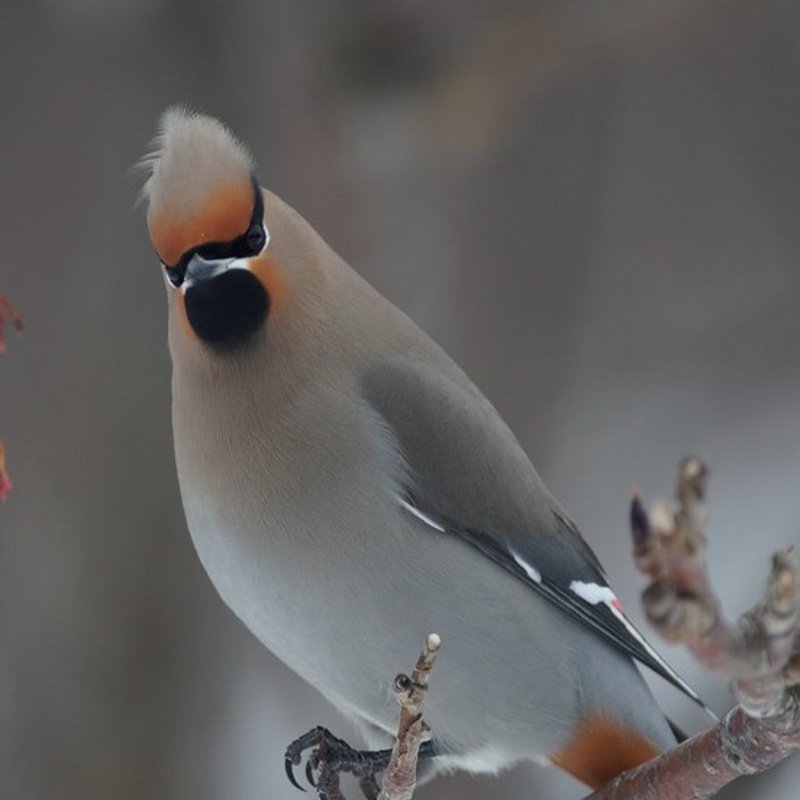In the northern woods of Europe and North America, the Bohemian waxwing or known in Latin as Bombycilla garrulus, breeds. There’s a pointed crest and buff-grey plumage. This species’ wings are striped with white and brilliant yellow, with red waxy feather ends.
Quick Overview: Bombycilla Garrulus – Bohemian Waxwing
Body size: Around 6.25-8.25 in (16-21 cm) and a weight of 57 g ( 2 oz)
Main colors: Gray, Red, White, Yellow
Range: Northern United States
Migratory Bird: Yes
Best time of the year to see in the U.S.: January, February, December
Conservation Status: Least Concern
Bohemian waxwing Description
Bohemian waxwings are starling-sized, with sleek crests and a gray body with a chestnut wash. The tail tip is yellow. Males have a bigger throat patch and a broader golden tail tip than females. This nickname derives from the waxy red ends on their secondary feathers. This species’ wings are striped with white and brilliant yellow, with red waxy feather ends.

Size
These birds have a length of 6.25-8.25 in (16-21 cm) and a weight of 57 g ( 2 oz). Their wings could range 13.14 in (33 cm).
Feeding
Bohemian waxwings eat fruit and insects. Mainly sweet fruits. The Bohemian waxwing’s big liver aids in sugar metabolism. They can also metabolize ethanol produced by the fermentation of sweet fruits. Summer Bohemian waxwings eat airborne insects. Insects, notably midges and mosquitos, make up 37% of their diet in late spring and early summer. Insects are preferred for nesting. When food supplies are few, they feast on flowers and tree sap.
Habitat
During the mating season, Bohemian waxwings prefer coniferous to coniferous-deciduous forests. It lives around lakes, streams, and marshes. They usually live in places with plenty of fruits and insects to eat. During migration, they leave forests for fruit-rich regions, including urban habitats. They move when food supplies dwindle. They are found in winter in forest or scrub regions with fruit on branches.
Behavior
Often observed flying between perches in bushes and trees. They hardly walk on earth. Waxwings self-care by scratching their heads with a foot over a partly extended wing and bathing in small puddles created by rain. Only mate-guarding has been seen in Bohemian waxwings. Male Bohemian waxwings will chase away outsiders trying to woo their partnered female.
Bombycilla garrulus Scientific Classification
- Kingdom: Animalia
- Phylum: Chordata
- Subphylum: Chelicerata
- Class: Aves
- Order: Passeriformes
- Family: Bombycillidae
- Genus: Bombycilla
- Species: Bombycilla garrulus
Subspecies
The three subspecies seem quite similar.
Best time of the year to see
The best time to see these birds in the United States is during the winter season (December to February).
Distribution of the Bohemian waxwing in the USA
The Nearctic and Palearctic waxwings are native. Their breeding range in the Nearctic area extends from middle Alaska to central Ontario. Most breeding areas do not extend south of southern British Columbia. They seldom breed north of Alaska or Nova Scotia. It migrates south in March and April to southwest British Columbia and the northern USA. Breeding occurs across northern Eurasia, most often in Scandinavia, Russia, and Siberia.
The Bohemian waxwing can be found in the following states in the United States – Idaho, Minnesota, Montana, Nebraska, North Dakota, and South Dakota.
